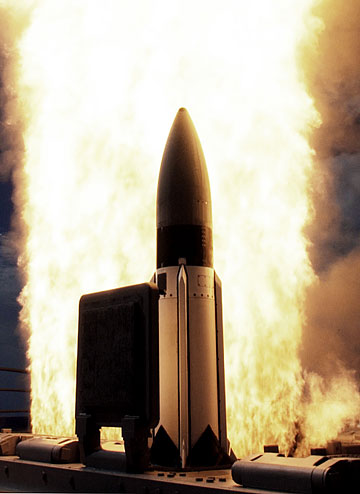
DEPARTMENT OF DEFENSE
The cruiser USS Lake Erie launched a missile yesterday northeast of Kauai in a joint test by the U.S. Missile Defense Agency and Japan's Defense Agency.
|
|
Missile test successful off Kauai
A Navy ship fires an interceptor carrying a Japanese nose cone
By Audrey McAvoy
Associated Press
The United States and Japan successfully tested an interceptor missile off Kauai yesterday, further advancing their ability to shoot down enemy ballistic missiles midflight.
The test aimed to check how well a Japanese-designed clamshell nose cone separated from a U.S.-designed interceptor missile. It was the first U.S. missile defense flight test to use Japanese parts.
The technology is for missile defense systems the U.S. and Japanese militaries are adopting amid worries about North Korea's development of long-range missiles and nuclear weapons.
The U.S. military is installing missile tracking radars and interceptor missiles on 18 U.S. Pacific Fleet ships. It is also equipping underground silos in Alaska and California with interceptor missiles.
During yesterday test, the USS Lake Erie guided-missile cruiser fired a Standard Missile-3 interceptor into the atmosphere above the Pacific about 60 miles northeast of Kauai, the U.S. Missile Defense Agency said in a news release.
There was no live target for the interceptor missile. Instead, the SM-3 aimed itself at a simulated target inserted into Aegis Ballistic Missile Defense program computers.
Cameras mounted on the missile recorded the Japanese clamshell nose cone separating from the warhead.
The new style of nose cone allows the missile's warhead to spot its target more quickly, shortening the time the interceptor needs to shoot down the enemy missile.
Japan's Prime Minister Junichiro Koizumi praised the outcome.
"The success shows how much our technological capability has been enhanced," Koizumi told a group of reporters in Tokyo. "I hope that Japan and the United States will further advance their research."
The United States and Japan started jointly researching ballistic missile defense technology in 1999, one year after North Korea test-fired a long-range missile over northern Japan.
Pyongyang's surprise test alarmed Tokyo and spurred a strong Japanese interest in missile defense. Analysts say North Korea's ballistic missiles are capable of hitting all of Japan as well as Hawaii, Alaska and perhaps portions of the U.S. West Coast.
In 2003, Japan became the first U.S. ally to buy elements of the U.S.-designed missile defense system when it upgraded Aegis radars already on board its naval destroyers. Japan also bought SM-3 interceptors from the United States.
Japan's Defense Agency is also planning to buy 124 Patriot surface-to-air missiles by 2010.
Yesterday's test follows a successful test off Hawaii in November, when the Missile Defense Agency and the Navy intercepted and destroyed a warhead as it separated from its booster rocket.

